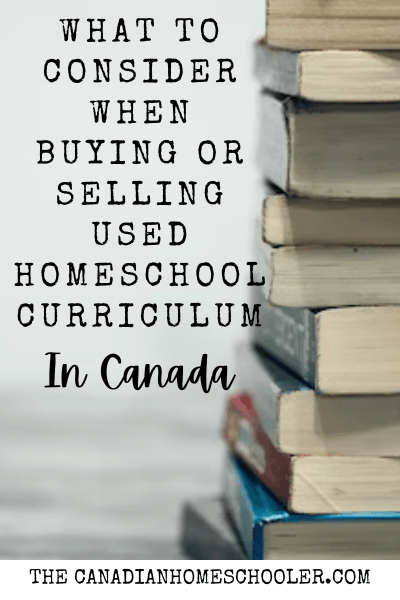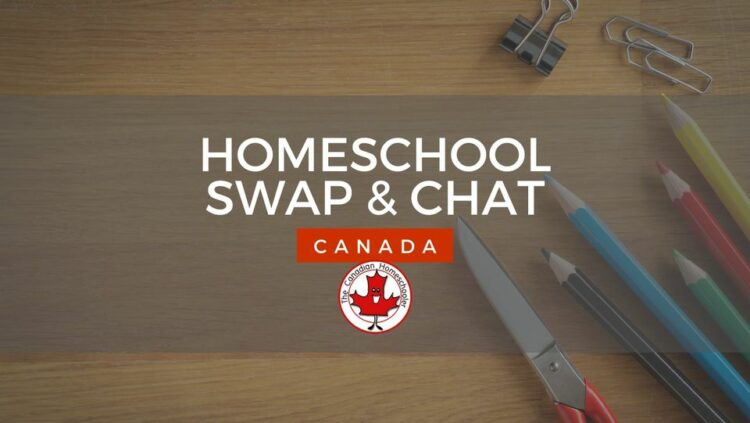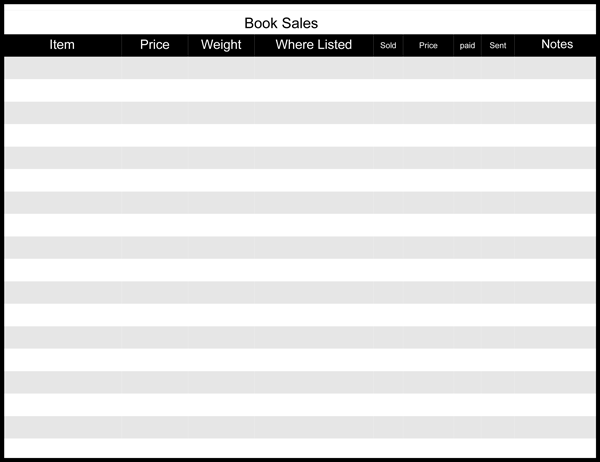Do you want to save some money and buy used books and homeschool curriculum? Or maybe you have a pile of books that you are done with and you’re looking for ways to sell it? Where do you start?

Where to Buy and Sell Used Curriculum
Let’s start with where you can both buy and sell used curriculum.
The easiest way for both seller and buyer, and the cheapest for the buyer (because there would be no shipping cost), is to buy and sell your books locally. Buyers also then have the opportunity to actually look through the curriculum or books and see the condition and contents. You could advertise them for sale or look for them to purchase in a local homeschool group which is usually through Facebook. If you aren’t part of a group, you could look for one on our list of Canadian Homeschool Support Groups on Facebook or ask around with local homeschoolers and let them know you have some things you are selling or looking for. Check to see if they allow a post in your local group for selling books or an ISO (In Search Of) ad.
If you can’t find what you are looking for or you need more options, you could try Facebook groups that are specific to your area, or country-wide. Here is a list of Canada-wide, provincial or area-specific groups that I am aware of on Facebook:
- Homeschool Swap and Chat Canada (Canada-wide)
- Ontario Homeschooling Materials
- Toronto and Area Homeschool Swap
- Central Alberta (Canada) Used Homeschool Materials
- Edmonton & Area Buy/Sell/Trade Homeschool Resources
- WISDOM Homeschooling Buy/Sell/Swap (Alberta)
- Homeschool Books for Sale (Calgary & Area)
- Secular Homeschool Alberta Easy Curriculum Sale
- Homeschool Swap Nova Scotia (HEMS Homeschooling)
- BC Home Learners Educational Buy and Sell
- Homeschool Swap and Support: Atlantic Canada
- SK Homeschool Buy/Sell/Trade (Saskatchewan)
- Manitoba Christian Homeschoolers Curriculum Swap
- Quebec and Area Homeschool buy/sell/swap/borrow
- Home Educators of PEI Buy/Sell/Trade
There are also other places that you might want to consider:
- Homeschool Used Curriculum Fairs- if there are enough homeschoolers in your area, you could run a used homeschool curriculum fair if there isn’t already one that is organized by your group, or attend one if you are looking to buy.
- Regular Buy and Sell Groups on Facebook- you could advertise or look for your items elsewhere on Facebook Marketplace in regular buy and sell groups, as some homeschoolers would not be in local groups, or some non-homeschoolers might want or be selling certain items, especially items like picture and chapter books or school supplies that aren’t homeschooling-specific.
- Curriculum-specific groups- have a look to see if there is a buy and sell Canadian Facebook group specific to the the used curriculum you are selling or hoping to buy! There are a few out there.
Considerations When Either Buying or Selling
Now let’s talk about things you need to consider when buying or selling used items:
- Firstly, it’s important to know if you are even allowed to resell or buy your items.
There are some things you cannot resell or purchase used, or you are allowed to purchase used but your use of that product will be limited. Don’t waste money on your purchase if you won’t be able to access all of the parts to the curriculum without a license or an online code only available to the first purchaser! Don’t get stuck with buying something unaware of copyright laws. Some publishers do not allow for resale, some licenses are for first purchaser only (often making the item useless/less useable for the buyer if they bought it), and digital copies either in their digital or printed form are illegal to resell or share. When in doubt, check the front of the book for copyright information or contact the publisher. Some special rules that I am aware of include the resale of products such as Rosetta Stone (cannot be resold), Switched on Schoolhouse (cannot be resold), Donna Ward/Northwoods Press (reproducible only for the original purchaser, all others have to use as a consumable), Gather Round (only items printed by Gather Round can be resold), Clearwater Press- the publisher of The One Year Adventure Novel- OYAN (OYAN cannot be resold because purchasers get a license to use the product and access all the parts). I am sure there are others I am not aware of, so make sure you check first! Selling partially used workbooks is also against copyright (same as reusing consumable workbooks with multiple children. You can only reuse it if it says in the front that it is reproducible). You also cannot sell something that is a consumable that you had your children use with a separate notebook as this practice is against copyright as well. Bottom line: when in doubt, check the copyright information or check with the publisher. Make sure you are not illegally selling or creating a situation for the buyer where they are not able to fully use the product.
2. What is the condition of the items?
Are there any pen marks, pencil marks, rips or stains? The value of what you are selling or buying goes down the worst the condition is. If you are buying, consider if any wear or marks will affect the use of the product.
3. What is the current price of the item?
Look it up online if you don’t know. Keep the edition in mind.
4. Are the books the most current edition, or an older edition? And how old?
The price that a seller can ask for the books you are selling goes down if it is an older edition, and even more so if it’s a few editions back! Be aware of this as a buyer.
5. Keep in mind that in general, a seller can probably expect around 40% of what they paid, but that goes down the older the books are and the worse the condition, and if the items need to be shipped.
Some items are common to find used and people aren’t willing to pay as much. If the buyer has to pay the cost of shipping as well, you can expect as a buyer to get even less to account for that cost.
6. If you are a buyer, keep in mind the cost of shipping if you need it.
You should still be getting a deal even with the cost of shipping. You can ask for a quote using your postal code.
7. If you are selling online and shipping your books, price them accordingly.
Shipping within Canada is expensive and often a textbook or a few books can cost at least $20 to ship. Prospective buyers will not be willing to spend almost as much as they’d spend to buy new on something used when they add in the cost of shipping.

Selling Used Curriculum and Books
An Online Seller’s Keys to a Successful Sale
There are many things to consider as an online seller that will make selling your items go easier for you. Here are some tips:
- Be aware of any rules on the site you are selling. Follow the rules! Don’t post items that are not for resale, are illegal to resell. Do not post items that are not allowed. Don’t post items “for pick up only” if the website states it is not allowed. Don’t post random non-homeschool related items!
- Price your items well! Remember people are looking for a deal. I have seen ads before stating “Paid $280. Asking $250 plus shipping”. Someone is not going to pay close to new price when they add in shipping. Yes, you might not have used the item and it is painful to take a loss. However would you rather sell it for something or have it sit in storage in your house?
- Take clear photos! I have seen ads with blurry or upside-down photos. People are less likely to buy from you because they can’t really tell what they are buying. It also helps if you provide a few inside photos like perhaps the table of contents.
- Once you make a sale, remove photos of the items that have sold and remove them from the description. Keep your ad up to date.
- If you are selling on Facebook, refresh your ad every 2 weeks or so. Check the group’s rules first to see how often you are allowed to refresh your ad.
- Give all the relevant information on the post. People are less likely to ask a bunch of questions if you are clear. List things like the item’s condition, any marks or which edition of the curriculum you are selling.
- Check your messages frequently so that you don’t miss a message from a potential buyer. Be willing to answer buyer’s questions.
- For Facebook, add tags to your post when posting it. People are more likely to find your items if they do a search if your post has tags.
- Be patient! Sometimes you have to wait a while to sell something. Consider dropping your price after a few weeks if you are looking for a faster sale. Or, if you are willing to wait, hang on and hope that it is just going to take longer.
- You will need to look up the cost of shipping your items. People will ask for a shipping quote using their postal code. If you have an accurate scale and measuring tape you can do this online at Canada Post. You could also take your item(s) to the post office and ask for a quote. If you ask for a quote, have your items already in their box/envelop as that adds to the weight. Some people will ask if the items will be able to go lettermail. There are particular dimensions and weights that items will fit lettermail, available on the Canada Post website. Sometimes splitting up the items into two lettermail envelopes can be cheaper than sending together as one package. Canada Post has now introduced Flat Rate boxes which can ship anywhere in Canada for the same price. They are often a better deal for shipping. They come with a tracking number and you can ship whatever fits in the box as long as it meets the weight requirements. If you have a good scale to make sure your items fit the weight limits and know the dimensions of these boxes to make sure your items fit, you could quote the person the price of the box plus tax.
- When shipping your items, be sure that they are packaged well. I have had items I bought from a seller be delayed because the package ripped! You want to make sure the buyer is receiving your items in the condition they are expecting! If you are using an envelope, be sure to tape along the edges and corners with packing tape to reinforce it. Make sure the address and return address are clear. Consider a bubble envelope or cardboard envelope. Make sure to include the purchase of these in the cost of shipping. To save money, you can re-use an envelope that you received items in, as long as you are sure that you properly cross out the previous addresses and make your shipping information clear. You can cross out and then cover the old address with a piece of paper that is taped down very well and write the new address on that paper.
- Ask for payment before shipping an item if you are shipping it. It is safest for the buyer to use PayPal with buyer protection, so be willing to use that as a means to help the buyer be confident in sending you money! You could either cover the fees yourself, work it into the purchase price, or ask that they cover the fees for you.
- Be prompt when someone has bought an item. Let them know when you are shipping it and where you are sending it from, and how long they should expect until they receive it. Send them a photo of the receipt and a tracking number if it was a package. If you make a positive impression, people are more willing to buy from you again and tell others that they had a good experience.
- Consider selling items at times of the year when homeschoolers are most looking for books. It doesn’t mean that your items won’t sell at other times, but they are most likely to sell from around March to August when people are considering their choices for the following school year.
We have a Book Resale Form to help you organize your used books and curriculum and get ready for some sales!
This printable is a form to help you keep track of what you are selling, for how much and where. There’s space to note the weight of the item so you can figure out shipping costs, as well as columns to check off when things are sold, for how much, and if you’ve sent it off.

>> Download your copy of this Book Sales Printable. <<
Selling at a Used Curriculum Fair
- Have your books organized and priced well. Either mark each item with a price, or have a section of the table with clear signs explaining what the prices are. For example, have one section of the table just for $1 books, one for $5 books and a box for free items. If possible, arrange it so people don’t have to dig very much. If there are marks or wear in the book, consider marking that with the price sticker.
- Group items that belong to one curriculum together either in a box or large clear ziploc bag so people are aware those items go together.
- Be present and friendly to answer questions.
- Allow people to browse and take their time to look through your items
- Have lots of change available and keep it on your body in a fanny pack.
- If possible, offer boxes or bags (keep them under the table) for people to hold their purchases
- Bring yourself snacks and water
- Bring yourself a folding chair in case you want to sit down behind your table
Buying Used Curriculum
Buying used curriculum or books can be a great way to save money if you stay aware during the process!

In addition to the places outlined above for both buying and selling used curriculum and books, here are some other places to check if you are looking to buy (or maybe even find for free!)
- Thrift stores or other used stores that sell books. I have occasionally seen homeschool curriculum for sale in thrift stores. Thrift stores are also a great place to buy general books that can be used in homeschooling such as chapter and picture books. It is also a great place to look for school supplies such as binders, hole punches, calculators, rulers, pencil cases and more. Check back often!
- Buy Nothing Groups. There are many groups under Buy Nothing Canada on Facebook (search for Buy Nothing Canada and your city or town). These operate in many communities, or you can start one. People give items away for free or you can get items for free. Sometimes there are items like books and school supplies. You can also post an ISO ad (In Search Of).
- Library sales. This is mostly for books like chapter books, picture books, field guides and other reference material. Often libraries get rid of books on a regular basis. Sometimes the copies have wear but are still perfectly useable. Other times the items are in like-new condition as they were donated and the library is unable to use them. Check with your library and ask when they are having a used book sale! Some libraries even have a shelf for selling used books on an ongoing basis.
- If you are friendly with your library, ask them to consider you before getting rid of books. Sometimes libraries are willing to give away books to someone that would use them if they are unable to use them anymore. Or they get a donation in and are looking for someone who could use it. Sometimes they ask for a small donation.
Keys to Successful Shopping for Used Curriculum and Books
- Keep in mind what you are looking for ahead of time. It can often be hard to find items so don’t wait for the last minute! You might want to look ahead if you know for sure you will use it. But don’t buy too far ahead and then decide you aren’t going to use that program anymore!
- If you are shopping online, be safe when sending money. The best way to do this is to purchase your items using Pay Pal, but do NOT use the “friends and family” payment as this offers no buyer protection. You can offer to pay the fee of the difference to pay them with buyer protection which is usually only a few dollars. If you are using an e-transfer, keep in mind that it is buyer beware. Consider if you lost the money because the item was not shipped, how much money are you willing to risk on that? Consider having a look at the person’s profile- how long have they been part of the group? Are you willing to take the risk or not. I have made many purchases on swap groups online and have only once lost money and thankfully not a lot. In general, I have found that people selling homeschool curriculum are an honest group of people. But you have to consider your risk and know that group admins can’t do anything to help other than message the person who might not respond. Buyer beware!
- Ask questions before buying or look thoroughly at the item if you are shopping locally. If the ad is not clear about the item’s condition and edition, be sure to ask. Make sure you get all your questions answered before committing to a sale. Ask questions like “is this from a smoke free/pet free home (if that is important to you). Or “does this item have any wear or marks anywhere” or “what edition is this?” You don’t want to receive an item only to notice that the entire thing contains highlighting or a little sibling scribbled all over the pages. If the item DOES have marks or wear, make sure you are paying accordingly. You can ask for photos of the wear or marks so that you know what you are committing to. Sometimes wear or marks are not important and can get you a cheaper price! Make sure that the item is the edition you are looking for.
- Use the internet to look up the cost to buy the item at the new price to be sure you know what is a good price to pay, including shipping if you are buying online. Be aware that shipping used books and curriculum in Canada is expensive, and that prices usually start at least $10-20 or more for shipping, unless the item is lightweight and thin and can go lettermail. Don’t give the seller a hard time for the cost of shipping as this is out of their control.
- If the item is priced too much for your budget, or you see that with shipping it will cost too much or close to the price of new, feel free to kindly and respectfully ask if they would consider a price you would pay, but also consider that you are asking another homeschool parent who also has a family and a budget. They might be more willing to drop their price if you explain that with shipping it is almost the cost of new, or if they have had the item posted for a while and want to make a quick sale.
- Make sure whatever you are buying has all the pieces required to use the program, or that you can still buy the missing pieces, or that they are optional. For example, sometimes people sell older edition textbooks for a popular science program, and the program uses notebooking journals as part of the program. You can’t buy the notebooking journals anymore for the program new, so you’d have to be okay with not using them as they are optional. Don’t expect to be able to use older editions with a newer edition product without checking that they correspond (they usually don’t, sadly).
- Be cautious when buying CD’s. Some are not compatible with newer computer technology and others will be damaged and unusable. You could request that the seller check them but often this is a “buyer beware” situation. Check the cost of replacing CD’s if they are even available to be replaced and consider if you would be willing to go that route if the ones you purchased were unusable, or if you would be willing to skip using them if they are an optional part of the program.
Overall, selling used curriculum can be a great way to get rid of things that didn’t work for you and your family, or items that you are done with. Buying used curriculum, books and supplies can save you money if you know what you are looking for and how to make sure you are getting a good price. Buying and selling locally is the easiest option because you can see the items and you know there won’t be any issues with payment, but oftentimes online offers more opportunities for buying and selling. Out of many many purchases or sales that I have made online through Facebook groups, I have had great success at saving money, earning some extra cash and helping to stretch our homeschool budget. I hope that these ideas help you to have a smooth process when buying and selling used books and curriculum!
- Engaging Ways to Learn About Canada’s Mammals - April 17, 2024
- Exciting Ideas for Studying Canadian Immigration in your Homeschool - March 17, 2024
- Canada’s Provincial and Territorial Birds: A Quick Guide for your Homeschool - February 16, 2024
